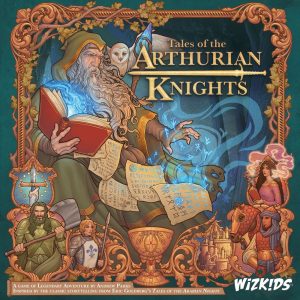 Tales of the Arthurian Knights is a reimplementation of the 2009 storytelling game Tales of the Arabian Nights. The original was famed for providing an immersive narrative experience surrounding characters such as Aladdin and Sinbad. Here the setting has changed to the titular knights of Camelot. And while it features a fresh entry point to what many consider a modern classic, does it also do enough to make it an adventure to seek out considering over a decade of innovation in the hobby?
Tales of the Arthurian Knights is a reimplementation of the 2009 storytelling game Tales of the Arabian Nights. The original was famed for providing an immersive narrative experience surrounding characters such as Aladdin and Sinbad. Here the setting has changed to the titular knights of Camelot. And while it features a fresh entry point to what many consider a modern classic, does it also do enough to make it an adventure to seek out considering over a decade of innovation in the hobby?
Designed by Andrew Parks and published by WizKids, Tales of the Arthurian Knights can be played by up to four players at approximately forty-five minutes per. It features heavy reading and is recommended for ages twelve and up.
Gameplay Overview:
The main board features seven regions that span from Brittany in the south to Scotland in the north. Within each region, there are five potential terrain types with a sixth being sea spaces that circumvent the lands. Players begin their adventure in Camelot and to do so must choose one of eight potential knights to be their avatar.
Each knight’s player board features a turn structure guide, end of era scoring information, as well as the main feature: a bank of twelve skills to power up through adventuring. These skills are separated into four categories (Martial, Spiritual, Courtly, and Wilderness) with three skills in each. Players begin with three skills enhanced by adding them to the +1 column and over the course of play skills will rise and fall in power.
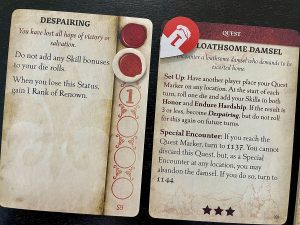
There are three eras in a full game, each era broken up into four turns. Players begin with a starting quest and mark the region(s) on the map that they must reach to complete it. And then they’re off! Each turn players proceed based on their movement stat, reach a location, and complete an encounter. Encounters can be standard, in which players draw from an encounter deck to see what they’ve happened upon, or they can be special and interact with quests.
Enter the massive Book of Tales which features all the story entries. Standard encounters happen more often and come in a variety of options. Drawing a card reveals either a location, a character, or an event. Locations open new paths to explore, whereas events and their entries in the storybook correspond to the current era. Character cards that are drawn also necessitate drawing a feature card to determine which entry to read.
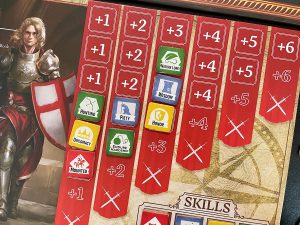
There are a lot of interesting choices at play in each encounter. Knights must consider their skill power levels as well as their location’s value in many instances to determine which path to take. This portion of player’s turns becomes a choose-your-own-adventure style experience, and upon selecting the route to take, they must roll a die to determine whether they’ve succeeded or not. An example would be needing to complete a skill check using your warfare skill, which is powered up at +2, and needing to pass a 4-value check. If you roll two or better on the six-sided die, the +2 boosts it to be equal to or greater than the test. Success!
Whether players succeed or fail, the outcome always produces results. Successes may bring about skill enhancements, treasure cards, and even powerful statuses. They also may provide destiny points which determine the endgame winner. Failures may boost skills as well, but they may also provide statuses that may hinder progress. Each knight has an identical stack of status cards available to them.
Play continues with each knight taking a separate turn of moving and facing an encounter. The narrative shifts to match the current era based on the entry numbers associated with them. Knights may also find ways to boost their renown throughout the land in three different areas: divinity, romance, and villainy. Players are free to choose any option they feel best represents their character if they happen upon them during play. The further they progress on renown tracks, the further they can move, and their destiny potential increases as well.
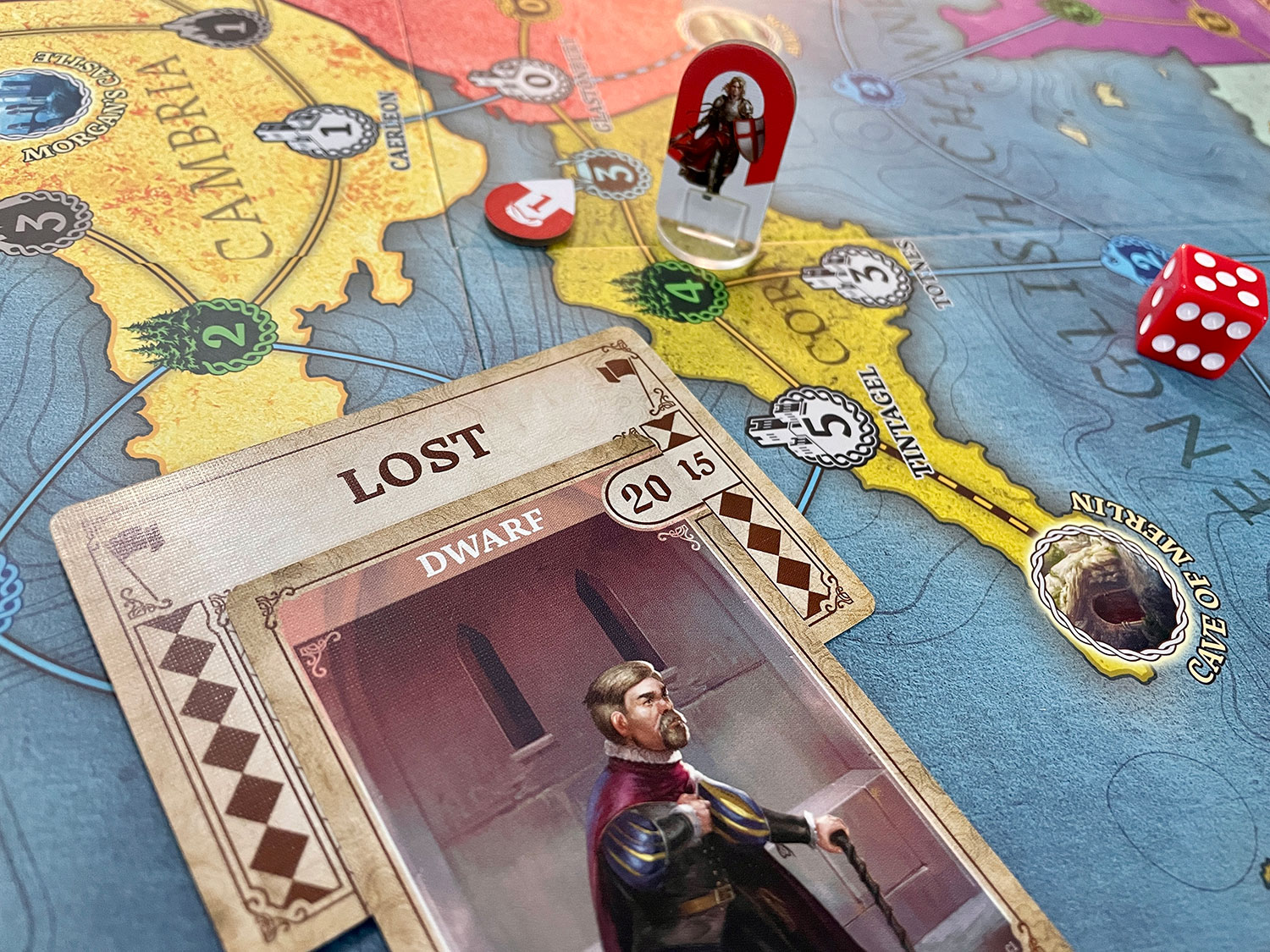
Game Experience:
Tales of the Arthurian Knights thrives as a narrative experience. It relies heavily on its Book of Tales and the myriad pages within. The writing not only fits the setting but digs into the lore and finds ways to surprise you with its outcomes. I’ve experienced something as simple as delivering a missive, and I’ve encountered beings and events on such a grand scale as to increase my renown throughout the land.
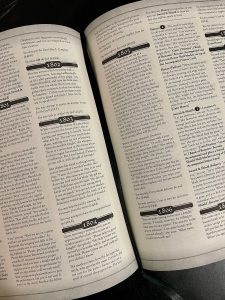
If you’ve played Arabian Nights, you’ll know what to expect here. If not, a modern-day equivalent would be something akin to Red Raven’s narrative driven games such as Above and Below. Discover, read, choose. A very simple set of steps that requires player buy-in related to the quests that they are undertaking. Player agency is directly related to their quest choices.
Where this differs from newer narrative adventures is that it lacks a separate set of mechanisms outside of the story. Beyond the role of a single die for skill checks, and perhaps some benefits provided from a treasure or status card, there is no other interaction. Players also do not interact on the map and instead take turns reading passages for each other. That may be all you are seeking, and if so, this game is ready to shine for your group.
Arthurian Knights is a love letter to its predecessor. It streamlines play and provides clever card systems for navigating narrative options. The simplicity of matching an encounter card to an era-specific set of numbers never gets old. And based on the breadth of stories in the Book of Tales, it is hard to imagine players finding duplicate entries in their early sessions. Even if it is providing a similar choose-your-own-adventure pathway, it feels fresh.
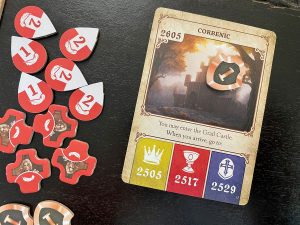
I would have liked to see more development related to making each knight feel more alive within the story. Outside of familiar names like Lancelot or Gawain, each knight is the same. Providing lore-based aspects to each of them that then interacted with certain storybook entries would’ve been a nice touch. Or even just making them move differently or start with a unique status.
In trying to update an older classic, Arthurian Knights plays it safe too often. By sticking to the simple die roll to determine a story beat, it provides quick resolution and speeds up gameplay, but it also begins to feel too punishing for some as their lack of luck finds them suffering with negative statuses and unfulfilled quests. Powering up skills can feel strategic in the moment, but without knowing what each encounter brings, it’s all a guessing game. Reworking the interaction between players and the narrative would’ve been nice to see.
As such, Arthurian Knights becomes more of an experience than a game. It’s best played with others so the tale can be realized through multiple eyes. It doesn’t quite work as a solo game because of this. And at four players it can run a little long. Three was the perfect count for my sessions and it was nice to see that each knight had very different adventures along the way.
Final Thoughts:
Tales of the Arthurian Knights brings a familiar setting to the table and allows players to dive even deeper into the lore of Camelot. The writing is excellent, the choices are fun, but the overall gameplay loop lacks substance. This is a light experience, one that does take some time to complete, but the tales may be enough to hold your attention. The Book of Tales is a massive and well-produced tomb with plenty of stories to discover. Ultimately, your enjoyment will relate to the immersion level of everyone at the table. Those that do not enjoy role-playing may find it too monotonous after several plays. I enjoyed my time here, but its lack of layered mechanisms may prevent it from seeing the table often.
Final Score: 3 stars – Narrative adventure that never quite delivers the holy grail.
 Hits:
Hits:
• Excellent writing and immersive lore
• Encounter card system
• Status card system
• Replayability and flexible game length
Misses:
• Luck-based encounter resolution
• Knights lack identity
• Renown tracks
• Needs more layered gameplay
Source: Board Game Quest



